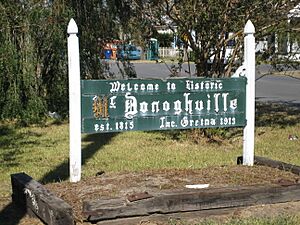McDonoghville facts for kids
Quick facts for kids
McDonoghville
|
|
|---|---|
|
Community
|
|

Sign marking old McDonoghville boundary in Gretna
|
|
| Nickname(s):
McDonogh
|
|
| Country | United States |
| State | Louisiana |
| Parish | Orleans and Jefferson |
| Established | 1815 |
| Founded by | John McDonogh |
| Time zone | UTC-6 (Central (CST)) |
| • Summer (DST) | UTC-5 (CDT) |
McDonoghville, sometimes called simply McDonogh, is a community in Louisiana. It is part of both Algiers, New Orleans and Gretna. McDonoghville is located in Jefferson Parish, Louisiana.
Discovering McDonoghville
McDonoghville is located on the "West Bank" of the Mississippi River. It sits right on the border between two areas: Jefferson Parish and Orleans Parish.
Over time, parts of McDonoghville became part of bigger cities. The Orleans Parish side joined Algiers and then New Orleans in 1870. The Jefferson Parish side became part of Gretna in 1913. In 2020, Gretna started working to get McDonoghville recognized as a historic place. This means it has special historical importance.
Like many neighborhoods around New Orleans, McDonoghville has local shops. It also has a playground named McDonogh. This area is mostly residential, meaning many people live there.
There are two small cemeteries in McDonoghville. St. Bartholemew was started in 1848, and St. Mary was started in 1866. Both are cared for by the Church of the Holy Name of Mary. This church's parish began in 1848, and the church building was completed in 1929.
One of the largest businesses in the community is Mardi Gras World. This company designs and builds amazing floats for the Mardi Gras parades. They also create huge fiberglass sculptures for other businesses.
The Story of McDonoghville
Before McDonoghville was founded in 1815, the land was a large farm. It was called the Montplaisir plantation. Jean-Charles de Pradel built this plantation in 1750. He got the land in 1737 from Étienne Perier. Perier had received it as a gift when he became governor of Louisiana in 1726.
In 1813, a kind man named John McDonogh bought the property. He started dividing the land into smaller pieces to create McDonoghville in 1815. This was the first planned community in Jefferson Parish. McDonogh rented and sold these properties to white workers and free people of color. This included people he had previously enslaved. He hoped to help them move to Liberia as part of a special project. Because of this, McDonoghville was sometimes called "Freetown."
By the 1880s, McDonoghville became a busy center for railroads. It had a roundhouse, which is a place to store and repair trains. There were also many rail yards and train tracks. A powerful railroad owner named Jay Gould owned so much land here that an 1896 map called the area "Gouldsboro."
Around the same time, McDonoghville also became a place where many things were made. German immigrants settled in the town first. Later, Irish and Italian immigrants moved there in the late 1800s and early 1900s. Good ferry service connected McDonoghville to the East Bank of the river. This made it easier for the community to grow.

